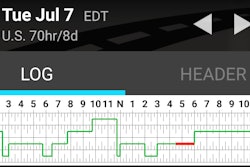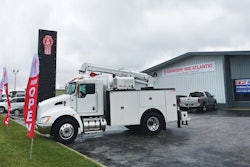For a more up-to-date story reflecting the 2020 hours of service changes and their specific impacts on split-sleeper logging, follow this link for a similar example, with a video tutorial, under the new rules, generally more permissive for splitting rest without losing valuable duty time.
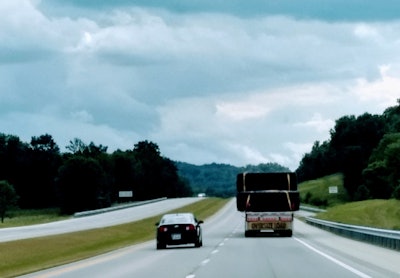
I imagine to a lot of you this is nothing you don’t know already, but I’ve had more than one inquiry of late into the FMCSA’s hours of service rule’s current sleeper-related provisions. The latest inquirer wondered why FMCSA requires drivers who utilize the sleeper-berth line to log at least 8 consecutive hours in the berth, yet his ELD doesn’t re-set his daily hours after such time is completed.
The short answer, of course: That 8-hour requirement is there for those who would take advantage of the 8/2-hour split of the required 10-hour off-duty period, allowed for in the regs. To reset daily hours in total, he’d need to at some point take a 10-hour off-duty period.
The 8/2 split (or 2/8 — it doesn’t matter which portion comes first) is being newly scrutinized by many around trucking in the wake of the ELD mandate, as it’s perhaps the principle allowance for off-duty-period flexibility in the regs.
FMCSA’s pilot test of greater split-sleeper flexibility, which I’ve brought up numerous times now as it languishes in preparatory processes at DOT (most recently here), is looking to run a trial in which drivers use more even splits of the 10-hour required off-duty period, perhaps in ways that offer a model somewhat similar to drivers’ pre-14-hour-rule methods for splitting the berth period.
Yet overlaying the 14-hour rule in the current 8/2 split allowance is not exactly simple. The regs complicate matters by allowing for the at-least-8-hour portion of the split to be excluded from the 14-hour clock, but not so for the at-least-two-hour break.
Here’s a hypothetical series of logs from T. Dills Trucking leading into the current day that might help illustrate it for those who are iffy in their understanding of it, as I have been when it’s been a while since I’ve thought about it.
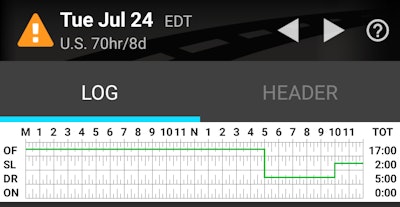 Let’s say I started my duty day after a long off period in Ohio (no pretrip — yikes, will probably pay for that later) and rolled for five hours starting at 5 p.m. Tuesday to Lexington, Ky., to start my duty day. I’ve got to be loading tomorrow just after 6 a.m., though, so instead of taking 10 down, I can only get in eight in the sleeper, thus starting the split-sleeper cycle. (As suggested above, for split-sleeper to work, the at-least-eight-hour period must be logged sleeper berth, not off-duty. The shorter period can be either off-duty/sleeper or any combination of the two.)
Let’s say I started my duty day after a long off period in Ohio (no pretrip — yikes, will probably pay for that later) and rolled for five hours starting at 5 p.m. Tuesday to Lexington, Ky., to start my duty day. I’ve got to be loading tomorrow just after 6 a.m., though, so instead of taking 10 down, I can only get in eight in the sleeper, thus starting the split-sleeper cycle. (As suggested above, for split-sleeper to work, the at-least-eight-hour period must be logged sleeper berth, not off-duty. The shorter period can be either off-duty/sleeper or any combination of the two.)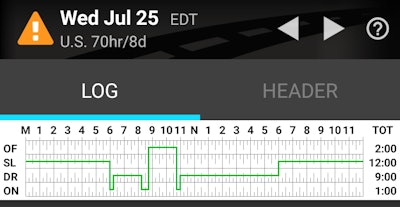 When starting a sleeper split under the current rules, calculation of the 11- and 14-hour limits resets after each break to begin after the previous off-duty period taken. At 6 a.m. when I go on-duty to do an ultra-fast pre-trip and load (in a grand total of 15 minutes — this isn’t the real world, folks) I have thus 7 hours of driving and 9 hours of potential on-duty time ahead of me. I get to that calculation by going back to 5 p.m. the prior day, the end of my prior off-duty period, and excluding the eight-hour berth period from the duty calculation. Continuing on, I drive the partial load a couple hours to Bardstown, Ky., arriving around 8:15 and staging to fill the load for the next 30 minutes on-duty, at which point they give me a time for when things will be done. I release myself from duty, visit a local distillery for a tour, skip on the beverages at the end and return to go back on-duty and drive. My 14 when I go back on-duty resets to begin at 6 a.m., meaning I now have 9 hours of potential drive time ahead and 9:15 of on-duty time, as the two-hour off-duty period does not “stop the clock,” unlike eight-hour periods in sleeper splits.
When starting a sleeper split under the current rules, calculation of the 11- and 14-hour limits resets after each break to begin after the previous off-duty period taken. At 6 a.m. when I go on-duty to do an ultra-fast pre-trip and load (in a grand total of 15 minutes — this isn’t the real world, folks) I have thus 7 hours of driving and 9 hours of potential on-duty time ahead of me. I get to that calculation by going back to 5 p.m. the prior day, the end of my prior off-duty period, and excluding the eight-hour berth period from the duty calculation. Continuing on, I drive the partial load a couple hours to Bardstown, Ky., arriving around 8:15 and staging to fill the load for the next 30 minutes on-duty, at which point they give me a time for when things will be done. I release myself from duty, visit a local distillery for a tour, skip on the beverages at the end and return to go back on-duty and drive. My 14 when I go back on-duty resets to begin at 6 a.m., meaning I now have 9 hours of potential drive time ahead and 9:15 of on-duty time, as the two-hour off-duty period does not “stop the clock,” unlike eight-hour periods in sleeper splits.I roll for seven hours then to the Birmingham, Ala.-area facility for partial offload in the early a.m., then, happy I can actually roll seven hours straight without needing to stop for anything (impossible everywhere but in my own imagination and/or for those of you who excel at this sort of thing) and also delighted I can actually park and sleep at this place. I get there with a couple hours to spare on both drive and 14-hour limits. It’s 6 o’clock and they’re way backed up. They give me a time for unload.
Early to bed, early to rise. G’night.
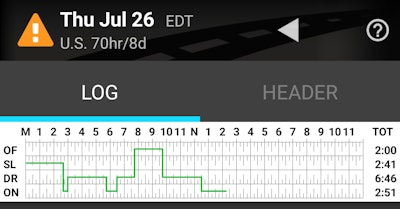 It’s tough to wake at 2 a.m. for most of us, so I manage to get cracking a little after 2:30 in often sunny but now quite dark Birmingham, where dock hands are hard at work as I rub the sleep out of my eyes to watch them make quick work of some skids. Great parking and bathroom facilities at this receiver, too — oh, the wonders of the imagination! When I come back on-duty for all of this at about 2:45 a.m., I have to recalculate available drive and duty hours. The eight-hour berth period doesn’t count toward the 14, so I’ve got: 4 hours of available drive time, and just under 7 hours of available on-duty time. Good thing. I’ve got a couple-hour haul up 65 in the direction of Nashville to offload the rest of this at 6 a.m., then about an hour of Southerly movement back into Alabama to position for the next load. I get it all done in about 5 hours of duty time, then crash out for a couple hours. Coming back on-duty, I recalculate my 14 and 11 limits again, including the two-hour nap against the newly available 14, which started at about 2:45 or thereabouts. It’s almost 10 o’clock, so I have about 7 duty hours possible, a theoretical 8 or so of drive time (moot by now given the erosion of available duty hours). I drive for a few hours and stop to sit down and figure out all these calculations on my computer for a couple more, on-duty…
It’s tough to wake at 2 a.m. for most of us, so I manage to get cracking a little after 2:30 in often sunny but now quite dark Birmingham, where dock hands are hard at work as I rub the sleep out of my eyes to watch them make quick work of some skids. Great parking and bathroom facilities at this receiver, too — oh, the wonders of the imagination! When I come back on-duty for all of this at about 2:45 a.m., I have to recalculate available drive and duty hours. The eight-hour berth period doesn’t count toward the 14, so I’ve got: 4 hours of available drive time, and just under 7 hours of available on-duty time. Good thing. I’ve got a couple-hour haul up 65 in the direction of Nashville to offload the rest of this at 6 a.m., then about an hour of Southerly movement back into Alabama to position for the next load. I get it all done in about 5 hours of duty time, then crash out for a couple hours. Coming back on-duty, I recalculate my 14 and 11 limits again, including the two-hour nap against the newly available 14, which started at about 2:45 or thereabouts. It’s almost 10 o’clock, so I have about 7 duty hours possible, a theoretical 8 or so of drive time (moot by now given the erosion of available duty hours). I drive for a few hours and stop to sit down and figure out all these calculations on my computer for a couple more, on-duty…So you probably get the point by now about how the 14/11 period rolls in the current version of split-sleeper use. Here’s where I was when I screenshot the logs above in the BigRoad app (non-ELD) version I used to help double-check my work:
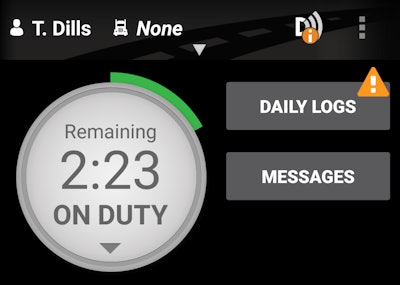
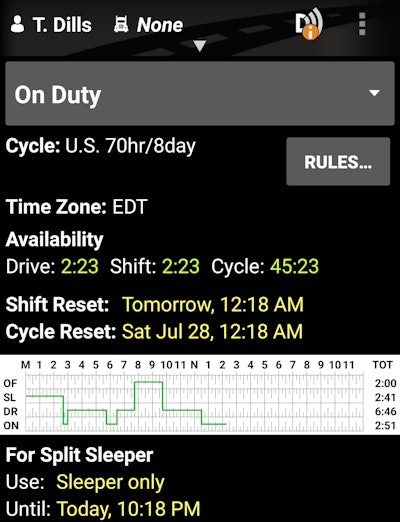
Much of the talk around changes in sleeper splits has been around allowing the shorter periods in the split to function like the 8-hour period in the current split — to not count against calculation of the 14-hour on-duty limitations. At least that’s been my understanding, and part of the recent petition put forward recently by the ELD or Me folks. If it had been possible to exclude the two-hour break on the final day from the 14, I’d have had that much more drive time to roll, for instance, given those mid-cycle off-duty hours might as well be treated like on-duty time.
As for the rest of the example above, for those of you who’ve remained mystified by the 8 and 2 split, I hope it helps. For those of you not so mystified: feel free to offer corrections and clarifications if I’ve missed anything. As I remarked under a discussion on Facebook recently with owner-operator Phil Killerlain and several others, thinking about and communicating this particular topic makes my head hurt a bit.
If anything’s unclear, hit me in the comments or with a message or a call.
Stay safe.

